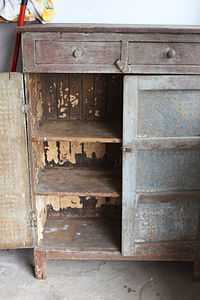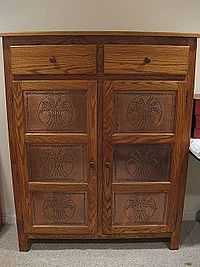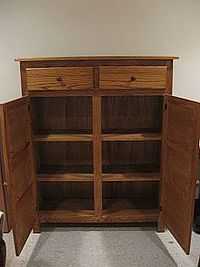Pie safe


A pie safe, also called a pie cupboard, pie chest,[1] kitchen safe, and meat safe,[2] is a piece of furniture designed to store pies and other food items. This was a normal household item before iceboxes came into regular use. It was considered an important part of the American household starting in the 1700s and continuing through the 1800s.[3]
The pie safe was used to store not only pies, but also meat, bread, and other perishables, protecting them from vermin and insects.[3]
A common pie safe is made of wood, is around the same size as a large bureau, and approximately eighteen inches deep. The shelves within the storage area are often perforated. It normally has two hinged doors on the front. These doors, and usually the sides,[2] are ordinarily ventilated either with tin plates with punched holes, or screens. The holes in the tin are often punched to produce an image such as a simple shape, or something more intricate like a church scene, eagles and stars, or even a Masonic emblem.[3] A notable design is the Wythe County pie safe, which has a distinctive tulip pattern.


Pie safes that are freestanding are ordinarily made with long legs to keep it away from the floor. Some were wall-mounted or suspended from the ceiling.[3] Most have a drawer, usually above the pie storage area, but sometimes below.[2]
In Cajun or Creole Louisiana, a pie safe is referred to as a garde-manger or a garde de manger. Pie safes from this region had doors with punched, tin panels, known in the region as tôles de panneaux, or were inlaid with baluster, closely spaced. These items of furniture were considered utilitarian, as opposed to decorative, and were often coloured dull red, referred to as gros rouge.[4]
The origin of the name of chess pie may have come from the term "pie chest", another name for a pie safe.[5]
Pie safes are considered to be collectable antiques and are commonly reproduced. They are popular pieces in the shabby chic interior design style.[6]
A notable pie safe maker was the American industrialist and founder of PPG Industries (then known as the Pittsburgh Plate Glass Company) Captain John Baptiste Ford, who made tin pie safes, selling them throughout the United States.
References
- ↑ Egerton, John. "Southern Food: At Home, on the Road, in History". p. 330.
- ↑ 2.0 2.1 2.2 Wilkes, Ralph S. (1982). "Built This Colonial Pie Safe". Popular Mechanics (August): 91.
- ↑ 3.0 3.1 3.2 3.3 Haedrich, Ken (2002). Apple Pie: 100 Delicious and Decidedly Different Recipes for America's Favorite Pie. Harvard Common Press, U.S. p. 250. ISBN 1558322256.
- ↑ Jay Dearborn Edwards and Nicholas Kariouk Pecquet du Bellay de Verton (2004). A Creole Lexicon. Louisiana State University Press. p. 107. ISBN 9780807127643.
- ↑ "Taste of the South: Chess Pie Recipes". Southern Living. Retrieved 2013-04-15.
- ↑ "Shabby Chic Decorating". Source. Retrieved 23 May 2011.
|first1=missing|last1=in Authors list (help)
External links
| Look up pie safe in Wiktionary, the free dictionary. |